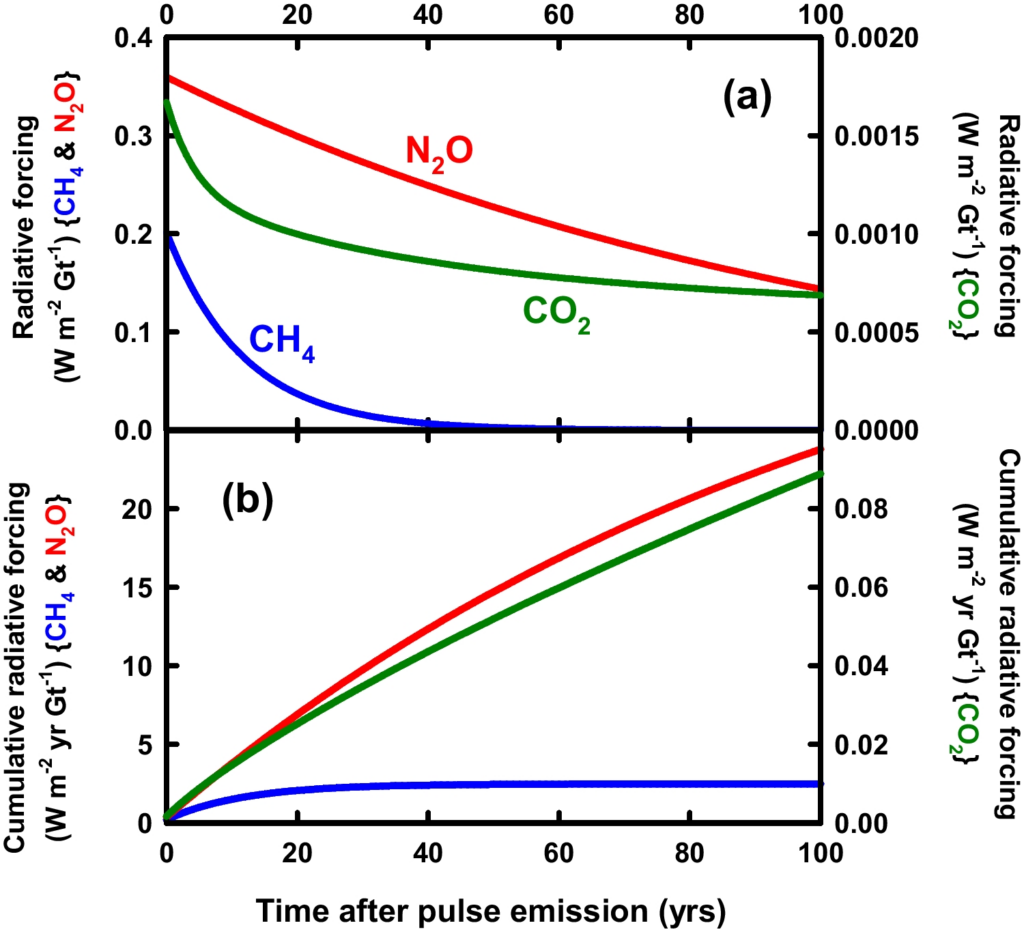Evaluating metrics for quantifying the climate-change effects of land-based carbon fluxes
New paper published in the International Journal of Life Cycle Assessment, based on a study carried out in the frame of IEA Bioenergy Task 45 (Sustainability). Full paper available in open access at springer.com
Growing concern over climate change has increased interest in making use of the biosphere to reduce net greenhouse gas emissions by replacing fossil energy with bioenergy or increasing land-based carbon storage. An assessment of the effectiveness of these options requires detailed quantification of their climate-change mitigation potential, which must employ appropriate metrics to translate biophysical changes into climate-change impacts. Metrics, such as Global Warming Potential (GWP) and Global Temperature change Potential (GTP), enable emissions of different GHGs to be weighted relative to a reference GHG emission. For example, GWP100 (= cumulative impact of an emission pulse over 100 years) is used for national reporting under the UNFCCC to quantify the warming contributions from all country-wide net emissions of different GHGs from all sources and sinks. Metrics enable the net emissions of different gases to be expressed in the common units of CO2 equivalents (CO2eq). However, the various currently available metrics use different proxy measures (e.g. radiative forcing, temperature changes, or others) as surrogates for climate-change impacts. the current application of different metrics leads to ambiguous results, with strongly contrasting assessments for the same GHG fluxes, especially in the comparison of short-lived (such as CH4) and long-lived GHGs (such as CO2 and N2O). This causes confusion for practitioners, decision-makers and the public and is likely to result in adoption of suboptimal policies for climate-change mitigation. The study’s aim was to provide criteria for the objective evaluation of metrics to build understanding of the significance of choice of metric and as a step towards building consensus on the most appropriate metric to use in different contexts. Fifteen available metrics were compared that represent conceptual differences in the treatment of biospheric carbon fluxes and the proxies used to approximate climate-change impacts. A set of evaluation criteria was proposed related to the metrics’ relevance, comprehensiveness, ease of application and acceptance by the research and policy community.
According to the selected set of criteria, the Climate-Change Impact Potential (CCIP) scored highest, followed by the Global Warming Potential (GWP) and Global Temperature change Potential (GTP). The high score of the CCIP was mainly due to its more complete coverage of three different aspects of temperature changes, namely instantaneous warming, cumulative warming and rate of warming, that together define the range of relevant climate-change impacts. Therefore, according to our evaluation criteria, it would be the most suitable metric for assessing the effect of different policy options on marginal climate-change impacts.
Specific points of attention:
- Most LCA studies have adopted the Global Warming Potential (GWP) with a characterisation time horizon of 100 years (GWP100) as the preferred metric to convert the emissions of different GHGs into a common unit. These studies generally do not acknowledge the timing of emissions and removals, so do not capture climate impacts resulting from any asynchrony between emissions and sequestration.
- The Global Temperature change Potential (GTP) has also gained prominence over recent years. It quantifies the impact of an emission pulse on the temperature change at a specified future time, with typical time horizons of 20, 50, 100 and 500 years. Results can be very different from the GWP assessment; for example, for CH4 emissions, GWP100 is 27 whereas GTP100 is just 4.7.
- As climate-change impacts are becoming apparent, and a need for urgent action is widely recognised, there have been calls to adopt shorter assessment horizons, such as 20 years, that would greatly shift the focus to short-lived GHGs such as CH4. However, if that were to lead to preferential emission reductions of short-lived GHGs while ongoing emission of long-lived GHGs such as CO2, it could be detrimental to achieving eventual climate stabilisation in the longer term.
- Many current climate-change policies and initiatives provide incentives to delay emissions or sequester C temporarily. These policies implicitly assume that there would be climate benefits from temporary C sequestration or emission reductions that occur sooner rather than later, as they will deliver immediate CO2 reductions and, therefore, reduce warming in the short term. However, there is no consensus whether such temporary storage delivers climate-change mitigation benefits in the long term.
- Direct land-use change (LUC) can be an important factor in the net GHG balance of bioenergy, leading to emissions during establishment of a bioenergy system, or, conversely, net carbon uptake if a bioenergy plantation is established on a site with low prior carbon stocks. Carbon payback time is not a concern in bioenergy systems that involve a sequestration phase prior to harvesting biomass, such as where energy crops are planted on abandoned agricultural land. In that instance, the sequestration phase should be included in quantifying the overall mitigation benefit of such options.

Figure: Radiative forcing after emissions of the three main GHGs, showing (a) instantaneous radiative forcing and (b) cumulative radiative forcing over 100 years. The scale for radiative forcing of CH4 and N2O is shown on the left axis and for CO2 on the right axis (mind the different scale). Source: Forster et al., 2021


